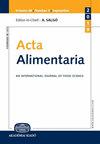HPLC/HILIC determination of biogenic amines in wines produced by different winemaking technologies
IF 1
4区 农林科学
Q4 FOOD SCIENCE & TECHNOLOGY
引用次数: 0
Abstract
The present study evaluated the effect of winemaking technologies on the concentration of different biogenic amines in Chardonnay wines. Wines produced from sedimented, inoculated must with active dry yeast without malolactic fermentation were compared with wine produced from nonsedimented must spontaneously fermented with malolactic fermentation. Histamine and putrescine concentrations were not significantly different in either variant. The highest concentration of histamine was 0.055 mg L−1, and the highest concentration of putrescine was 1.6 mg L−1 in both variants. Statistically significantly higher values of cadaverine (from 0.06 to 0.07 mg L−1), spermidine (from 0.8 to 1.4 mg L−1), spermine (from 0.15 to 0.25 mg L−1), and isoamylamine (from 0.40 to 0.46 mg L−1) were found in the variant made from nonsedimented must, in which spontaneous malolactic fermentation was performed. The higher concentration of biogenic amines in this variant may be due to the different composition of lactic bacteria during the spontaneous malolactic fermentation. A simplified, unpublished HILIC method of chromatographic separation of biogenic amines without prior deprivation with MS-MS detection was used to determine individual biogenic amines.HPLC/HILIC法测定不同酿酒工艺生产的葡萄酒中的生物胺
本研究评估了酿酒技术对霞多丽葡萄酒中不同生物胺浓度的影响。用沉淀的、用活性干酵母接种的、未经苹果酸乳酸发酵的啤酒酿造的葡萄酒与用苹果酸乳酸自发发酵的未沉淀的啤酒生产的葡萄酒进行了比较。组胺和腐胺的浓度在两种变体中都没有显著差异。组胺的最高浓度为0.055 毫克 L−1,腐胺的最高浓度为1.6 毫克 两种变体中的L−1。尸胺的统计值显著较高(从0.06到0.07 毫克 L−1)、亚精胺(0.8至1.4 毫克 L−1)、精胺(0.15至0.25 毫克 L−1)和异戊胺(0.40至0.46 毫克 L−1)存在于由非发酵啤酒制成的变体中,其中进行了自发的苹果酸乳酸发酵。该变体中较高浓度的生物胺可能是由于自发苹果酸-乳酸发酵过程中乳酸菌的组成不同。使用一种简化的、未发表的HILIC方法,在没有事先剥夺MS-MS检测的情况下,对生物胺进行色谱分离,以确定单个生物胺。
本文章由计算机程序翻译,如有差异,请以英文原文为准。
求助全文
约1分钟内获得全文
求助全文
来源期刊

Acta Alimentaria
农林科学-食品科技
CiteScore
1.80
自引率
0.00%
发文量
47
审稿时长
18-36 weeks
期刊介绍:
Acta Alimentaria publishes original papers and reviews on food science (physics, physical chemistry, chemistry, analysis, biology, microbiology, enzymology, engineering, instrumentation, automation and economics of foods, food production and food technology, food quality, post-harvest treatments, food safety and nutrition).
 求助内容:
求助内容: 应助结果提醒方式:
应助结果提醒方式:


